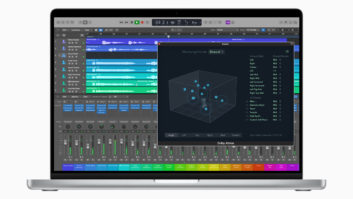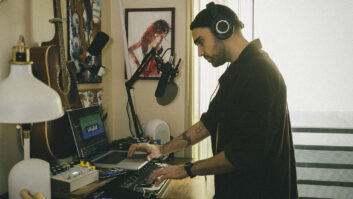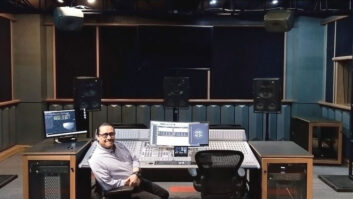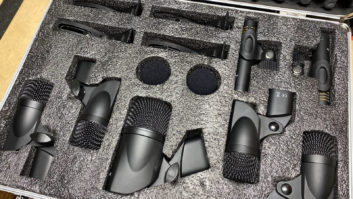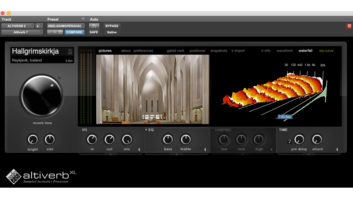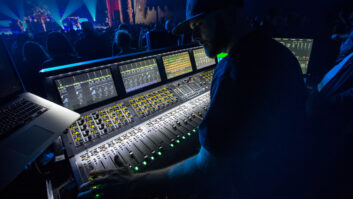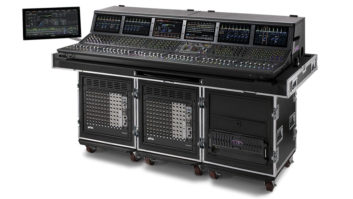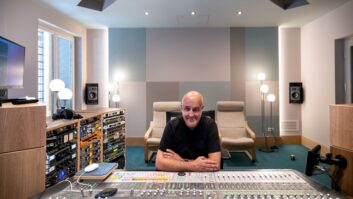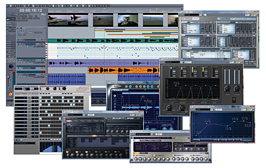
Cakewalk has been consistent about upgrading SONAR annually, and the improvements have been significant. For instance, SONAR 5 pushed the envelope by being the first 64-bit DAW, and last year SONAR 6 was fortified with ACT (Active Controller Technology), a dynamic means of remapping MIDI controls, AudioSnap audio quantizing, Session Drummer 2 and the robust VC-64 Vintage Channel.
SONAR 7 Producer Edition ($619) is packed with a slew of new features. A hefty MIDI overhaul includes Smart MIDI Tools and enhanced MIDI editing. Internal sidechaining and delay compensation for external hardware are also welcome features. The comprehensive Roland V-Vocal is also enhanced with MIDI functionality. True linear-phase mastering plug-ins, Eu-Con support, workflow enhancements and new delivery options are also included in this update.
Cakewalk SONAR 7’s work environment showing the LP-64 multiband compressor, Roland V-Vocal and the new Step Sequencer
DUELING SYSTEMS
I installed SONAR 7 on two machines with two different operating systems, including a Mac. Cakewalk hasn’t gone cross-platform, but advertises SONAR 7 running on a Mac under Boot Camp. I had a Windows XP partition on an Intel 2.66GHz dual-core Mac running OS 10.4.9 and a self-built Windows machine running Windows Vista Ultimate 32-bit. Powering the Windows machine was a 3GHz Intel Core Extreme CPU Q6850 with 4 GB of RAM. After the painless installations, both systems were updated to SONAR 7.0.2.
For audio interface duties, I used two different setups. The Windows Vista machine was coupled with a MOTU 828mkII FireWire interface. On the Mac system, I used a new Lynx AES16e card connected to a Mytek 8×192 AD/DA via AES/EBU connections. As for MIDI controller duties, an M-Audio Keystation 49e fit the bill.
SHOW ME THE MIDI
SONAR 7’s Integrated Step Sequencer view allows for easy creation and manipulation of drum programming and rhythmic, repetitive patterns. Each sequence can have up to 16 steps per beat with 64 beats per pattern, including support for odd meters and a “fit-to-quarters” function. Further controls include toggling between mono and polyphonic modes, articulation, swing and portamento.
I inserted a soft synth with an instance of Session Drummer 2; SONAR conveniently created a track folder with a MIDI track and an instrument track. I loaded a kit within Session Drummer 2, and to see the proper drum sounds in the Step Sequencer view, I assigned the appropriate drum map on the MIDI track output. Creating a pattern is as easy as left-clicking to add notes and right-clicking to remove notes. As the pattern cycled playback, I easily created a groove pattern that didn’t require much technical attention, allowing the creativity to flow. Once created, manipulation is as easy as Ctrl-click-dragging to join and Ctrl-right-clicking to separate notes. Velocity is controlled with a shift-drag up or down. Once you have an arrangement, Step Sequencer clips work just like MIDI Groove clips in Track view whereby you can just click-drag them out to repeat.
Streamlining workflow has always been a strong point for SONAR releases, and with V. 7 the application pushes forward in the MIDI department with Smart MIDI Tools. The original Select, Draw and Erase tools may be completely configured under the Options>PRV Tool Configuration menu. Tool behaviors based on the cursor’s position, left/middle/right mouse buttons and combinations with modifier keys can be programmed to any MIDI editing action. Once Tools are programmed to taste, you have a complete custom MIDI work environment that can be saved in presets. For those of you accustomed to other DAWs, you’ll appreciate built-in presets from programs such as Logic 7, Cubase and Digital Performer.
Other MIDI enhancements include a convenient MIDI Magnifier in the Piano Roll view, which allows you to cursor over dense MIDI data and edit without changing the overall environment zoom level: Select the MIDI Magnifier in the Tool Bar, hover over the MIDI notes with the mouse and a microscope action zooms in on the specific area, allowing you to edit away. Improvements to MIDI visuals include a Velocity Colorizer, which provides velocity-dependent color coding (tinting) of notes; and MIDI Meters (responsive to velocity information) are now standard in the Track and Console view. Additional MIDI editing functions added to the MIDI tool palette now include Split Notes, Glue Notes, Event Mute, Drag Quantize and Repeat. Further MIDI implementation is added to Roland V-Vocal 1.5 with Pitch-to-MIDI conversion, allowing, for example, a synth track accompaniment of a vocal performance via the vocal’s MIDI data for added texture or effects.
NEW INSTRUMENTS AND PLUG-INS
Virtual instruments are a welcome feature with any DAW, and SONAR 7’s impressive stock includes favorites like Session Drummer 2, the PSYN II subtractive synth and Pentagon I virtual analog synths; Cakewalk has also added a few more to the roster. DropZone is a drag-and-drop sampler and REX loop editor stocked with pads and atmospheres, basses, drum kits and REX loops. The Z3TA+ 1.5 is an analog-style synth offering filters, six oscillators, built-in effects and band-limiting technology. Dimension LE, a lighter version of Dimension Pro, features more than 400 sound programs spanning organ, bass, electric piano samples and synth sounds including the Garritan Pocket Orchestra, which comprises strings, brass, woodwinds, keyboards and percussion. Although I enjoyed playing with this library, some of the samples were a bit noisy for my taste. As an example, the Viola Legato 3 was a bit raspy regardless of which sample rate I used (I tried 48 to 192 kHz) or machine I used. This was more of a problem when isolated; once in a mix, the issue was masked. For the electronica crowd, Cakewalk also includes a version of its Rapture synthesizer, Rapture LE, with more than 200 programs and hundreds of oscillator shapes.
It’s always a bonus when you don’t have to spend a fortune on third-party plugs, and SONAR users have always been accustomed to greats like the Sonitus bundle, Perfect Space convolution reverb and SONAR 6’s VC-64. SONAR 7 sweetens the deal with new mastering plug-ins. The LP-64 linear phase EQ and the LP-64 multiband comp/limiter provide accurate control without any phase shifts, comb filtering or dull transients during processing. The LP-64 EQ offers 20 control points with the usual frequency, gain and Q manipulation. The multiband compressor includes two presets for mastering: lighter or stronger. A program-dependent release option provides five bands to control independent attack, release, threshold, ratio and gain. I applied these over bus masters, and the results were always impressive. The presets were great starting points and sonically were as good as other expensive plug-in bundles. Another polishing plug-in is Boost 11, a limiter/volume maximizer with a “look-ahead” feature and program-dependent release (PDR). Boost 11 provides dynamic waveform displays in real time of input vs. output, and lets you audition that loud, final mix sound.
SONAR 7 also now incorporates internal side-chaining for the Sonitus fx Gate, Sonitus fx Compressor and the VC-64. Triggering instruments with other instruments, de-essing and ducking was a breeze. Simply insert one of the supported plug-ins over a track and address an output of a bus on another track to feed the corresponding plug-in/track.
BUT WAIT, THERE’S MORE
Incorporating external gear with DAWs can be a bit of a latency challenge. SONAR 7 alleviates this issue with its new seamless External Inserts with automatic delay compensation. Available over a track or bus, you have control over send/return assignments, automation for send/return gain and phase. Workflow improvements have been made for faster track I/O assignments. Now you can assign consecutive or identical inputs over selected tracks. My only problem was, I couldn’t find a way to assign consecutive outputs over tracks, just identical outputs. This feature would be beneficial when the user is assigning all outputs to a mixing console. Other workflow enhancements include a new Dim Solo mode that allows soloing of tracks without completely muting the others; rather, it “dims” them at -6, -12 or -18 dB.
New import and delivery options keep this DAW current with the online audio world. SONAR 7 is fortified with the ability to import/export Sony Wave-64 (true 64-bit file format designed to overcome the 2GB limitation), AIFF, CAF, FLAC and SD2. To my surprise, with the immense popularity of iTunes, there is no support for AAC format. However, SONAR has a feature that supports external command-line audio encoders, so it is possible to configure this DAW to work with an app like FAAC (Freeware Advanced Audio Coder) to allow you to export AAC audio seamlessly from SONAR itself. SONAR 7 can now rip audio CDs with burning integrated within the app. Cakewalk’s Publisher 2 allows direct publishing online, enabling you to create playlists within a customized, streaming Flash-based music player. Publisher 2 connects to a Web host’s FTP account, where the player can be uploaded to an artist’s Website and generate an HTML tag.
A TRULY SELF-CONTAINED SYSTEM
It’s a no-brainer — if you implement MIDI into your workflow, SONAR 7 is well worth the upgrade. The new Step Sequencer allows drum programming to flow with minimal effort. In addition, complete customization and integration of the mouse with the Smart MIDI tools is a big time-saver. The MIDI Magnifier will leave many wondering how they ever worked without it. The new instruments — Rapture LE and Dimension LE — are attractive additions, especially Dimension with its abundant sounds including the Garritan Pocket Orchestra. The linear phase LP-64 EQ and multiband comp/limiter are great-sounding additions to the plug-in roster.
SONAR releases have always been stuffed with practical features. and V. 7 is no exception, with faster track assignments, a Dim Solo mode, internal sidechaining and hardware inserts. SONAR’s ability to create, complete and deliver music via Publisher 2 to an artist’s Website or MySpace account all “in the box” makes it truly a self-contained DAW.
Cakewalk, 617/423-9004, www.cake walk.com.
When he wrote this, engineer/studio owner Tony Nunes was rooting for his native Portugal to win the Euro Cup.
